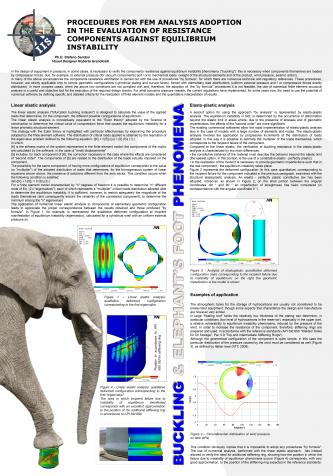
Buckling assessmer
In the design of equipment in pressure, in some cases, it is necessary to verify the components resistance against equilibrium instability phenomena ("buckling"): this is necessary when the components are loaded by compression forces, due, for example, to external pressure (for vacuum components) and / or to mechanical loads (weight of the structural elements and of the product, wind pressure, seismic action).
In many of the above circumstances the components resistance verification is carried out with the use of procedures "by formula", for which there are numerous technical and regulatory references. These procedures, however, are strictly applicable only to simple geometric configurations (cylindrical plating and curved funds), forced with elementary load distributions (uniform external pressure and / or compressive forces evenly distributed). In more complex cases, when the above two conditions are not complied with and, therefore, the adoption of the "by formula" procedures is not feasible, the use of numerical finite element structural analysis is a useful and objective tool for the execution of the required design checks. For what concerns pressure vessels, the current regulations have implemented, for some years now, the need to use the potential of numerical software by defining specific and detailed criteria for the realization of finite element models and the quantitative interpretation of results.
>> Linear elastic analysis
The linear elastic analysis ("bifurcation buckling analysis") is designed to calculate the value of the applied loads that determines, for the component, the different possible configurations of equilibrium.
The linear elastic analysis is conceptually equivalent to the "Euler theory" adopted by the Science of construction to determine the critical value of compression force that causes the equilibrium instability for a linear prismatic structural element.
The analogy with the Euler theory is highlighted with particular effectiveness by examining the procedure adopted by the finite element software.
The distribution of critical loads applied is obtained by the resolution of the eigenvalue problem defined by the following equation: ([K] + li [S]) {yi} = {0} (Eq (1).
in which:
[K] is the stiffness matrix of the system represented in the finite element model; the components of the matrix are calculated by the software, in the case of "small displacements"
[S] includes, for each component of [K], the correction necessary in the case where the effects are considered of "second order". The components of [S] are related to the distribution of the loads actually imposed on the component.
The possibility for the same component, of having more configurations of equilibrium corresponds to the value (or "multiplier") of the adopted distribution of loads that determines, for the homogeneous system of linear equations shown above, the presence of solutions different from the zero vector. This condition occurs when the following condition is satisfied:
det ([K] + li [S]) = 0 (Eq (2).)
For a finite element model characterized by "n" degrees of freedom it is possible to determine "n" different roots of Eq. (2) ("eigenvalues"), each of which represents a "multiplier" critical loads distribution adopted able to determine the equilibrium instability. It is sufficient, however, to restrict adequately the magnitude of the loads themselves (and consequently ensure the reliability of the considered component), to determine the minimum among the "n" eigenvalues.
The application of numerical linear elastic analysis to components of elementary geometric configuration leads to appreciate the proper correspondence between the results obtained and those produced "by formula". In Fig. 1, for example, represents the qualitative deformed configuration at incipient manifestation of equilibrium instability (eigenvector), calculated for a cylindrical shell with a uniform external pressure on.
>> Elasto-plastic analysis
A second option for using the approach "by analysis" is represented by elasto-plastic analysis. The equilibrium instability in fact, is determined by the occurrence of deformation beyond the elastic limit in areas where, due to the presence of stresses and of geometric imperfections, the effects of the "second order" are more significant.
The existing commercial softwares allow the rapid implementation of elasto-plastic analysis also in the case of models with a large number of elements and nodes. The elasto-plastic analysis involves the application by progressive increments of the distribution of loads adopted: in this way it is possible to estimate the multiplier of the loads themselves, which corresponds to the incipient failure of the component.
Compared to the linear elastic, the verification of buckling resistance in the elasto-plastic analysis is characterized by two main differences:
- the constitutive behavior of the material must describe the behavior beyond the elastic limit (the easiest option, in this context, is the use of a constitutive elastic - perfectly plastic)
- in the realization of the model it is necessary to provide geometric imperfections such that in the real component, the equilibrium instability takes place.
Figure 2 represents the deformed configuration (in this case quantitative) corresponding to the incipient failure for the component indicated in the previous paragraph, examined with the structural elastoplastic analysis. An elastic - perfectly plastic constitutive law has been adopted; moreover, as shown in Figure 2, on the shell portion between the angular coordinates -90 ° and 90 ° an imperfection of straightness has been considered (in correspondence with the angular coordinate 0 °).
>> Examples of application
The atmospheric tanks for the storage of hydrocarbons are usually not considered to be pressurized equipment; though some aspects that characterize the design and manufacture are however very similar.
In large "floating roof“ tanks the relatively low thickness of the plating can determine, in particular conditions (low level of hydrocarbons in the reservoir), especially in the upper part, a relative vulnerability to equilibrium instability phenomena, induced by the pressure of the wind. In order to increase the resistance of the component, therefore, stiffening rings are prepared and used, in accordance with the reference standards (API Std 650 "Welded Tanks for Oil Storage", Par. 5.9 "Top and Intermediate Stiffening Rings") .
Although the geometrical configuration of the component is quite simple, in this case the particular distribution of the pressure caused by the wind must be considered as well (Figure 3), as defined by Italian laws (NTC 2008).
This condition obviously implies that it is impossible to adopt any procedures "by formula". The use of numerical analysis, performed with the linear elastic approach, has instead allowed to verify the need for additional stiffening ring, showing how the position in which the failure due to instability of equilibrium phenomena occurs (Figure 4) corresponds, with very good approximation, to the position of the stiffening ring expected in the reference standards.






 Torna indietro
Torna indietro